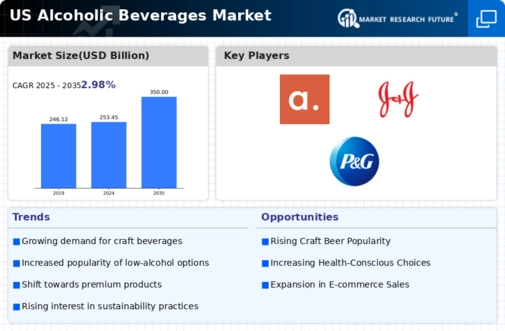The alcoholic beverages market in the US is characterized by a dynamic competitive landscape, driven by evolving consumer preferences and a growing emphasis on premiumization. Major players such as Anheuser-Busch InBev (Belgium), Diageo (United Kingdom), and Constellation Brands (US) are actively shaping the market through strategic initiatives. Anheuser-Busch InBev (Belgium) focuses on innovation and sustainability, launching new products that cater to health-conscious consumers. Diageo (United Kingdom) emphasizes digital transformation, enhancing its e-commerce capabilities to reach a broader audience. Constellation Brands (US) is pursuing regional expansion, particularly in the craft beer segment, which has seen a surge in popularity. Collectively, these strategies contribute to a competitive environment that is increasingly focused on differentiation and consumer engagement.
Key business tactics within the market include localizing manufacturing and optimizing supply chains to enhance efficiency and responsiveness. The competitive structure appears moderately fragmented, with a mix of large multinational corporations and smaller craft producers. This fragmentation allows for diverse offerings, yet the influence of key players remains substantial, as they leverage economies of scale and brand recognition to maintain market share.
In October 2025, Diageo (United Kingdom) announced a partnership with a leading tech firm to integrate AI-driven analytics into its marketing strategies. This move is likely to enhance consumer targeting and improve campaign effectiveness, reflecting a broader trend towards data-driven decision-making in the industry. By harnessing AI, Diageo aims to refine its product offerings and marketing approaches, potentially leading to increased sales and market penetration.
In September 2025, Constellation Brands (US) unveiled a new line of organic wines, responding to the growing consumer demand for sustainable and health-oriented products. This strategic launch not only aligns with current market trends but also positions Constellation as a leader in the organic segment, which is expected to grow significantly in the coming years. The introduction of organic wines may attract a new demographic of environmentally conscious consumers, thereby expanding the company's market reach.
In August 2025, Anheuser-Busch InBev (Belgium) invested in a state-of-the-art brewing facility in the US, aimed at increasing production capacity for its craft beer brands. This investment underscores the company's commitment to the craft beer segment, which has been gaining traction among younger consumers. By enhancing its production capabilities, Anheuser-Busch InBev is likely to strengthen its competitive position and respond more effectively to shifting consumer preferences.
As of November 2025, current competitive trends indicate a strong focus on digitalization, sustainability, and technological integration within the alcoholic beverages market. Strategic alliances are increasingly shaping the landscape, allowing companies to pool resources and expertise. Looking ahead, competitive differentiation is expected to evolve, with a shift from price-based competition towards innovation, technology, and supply chain reliability. This transition may redefine market dynamics, as companies that prioritize these aspects are likely to gain a competitive edge.














Leave a Comment